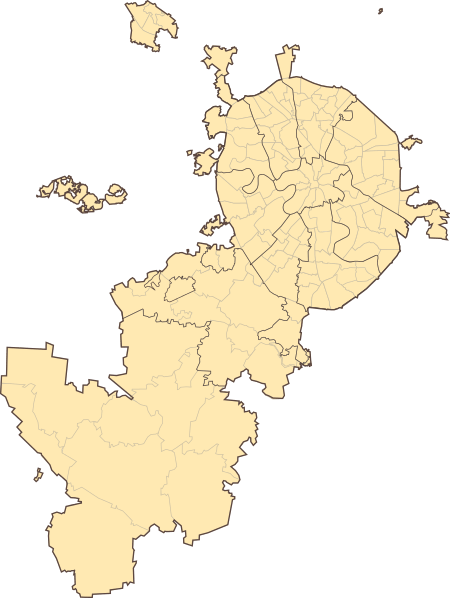White House (Moscow)
The White House (Russian: Белый дом, tr. Bely dom, IPA: [ˈbʲɛlɨj ˈdom]; officially: The House of the Government of the Russian Federation, Russian: Дом Правительства Российской Федерации, tr. Dom pravitelstva Rossiiskoi Federatsii), also known as the Russian White House, is a government building in Moscow. It stands on the Krasnopresnenskaya embankment. The building serves as the primary office of the government of Russia and is the official workplace of the Russian Prime Minister.
| The House of the Government of the Russian Federation | |
|---|---|
Дом Правительства Российской Федерации | |
The building in 2008 | |
 | |
| General information | |
| Type | Parliament |
| Town or city | Moscow |
| Country | Russia |
| Construction started | 1965 |
| Completed | 1981 |
| Design and construction | |
| Architect | Dmitry Chechulin, Pavel Shteller |
.jpg)
History
Soviet Union
The architects Dmitry Chechulin and Pavel Shteller designed the White House – originally called The House of Soviets. The overall design follows Chechulin's 1934 draft of the Aeroflot building. Construction started in 1965 and ended in 1981.
Following the completion of the building in 1981, the Supreme Soviet of Russia, which had until then held its sessions in the Grand Kremlin Palace, used the White House. The Supreme Soviet of Russia remained in the building until the end of the Soviet Union in 1991, as well as during the first years of the Russian Federation. In 1991 the Soviet Union issued a 50-kopeck stamp depicting the White House and honoring resistance to the 1991 Soviet coup d'état attempt.
Russian Federation
After the end of the Soviet Union, the White House continued to serve as the seat of the Russian parliament.
1993 Russian constitutional crisis
By sunrise on 4 October 1993, the Russian army encircled the parliament building, and a few hours later army tanks began to shell the White House. The White House stood damaged for some time after the 1993 Russian constitutional crisis, and the black burns from tank shelling became famous, so much so that it became traditional to photograph newly-weds in front of its damaged façade.
The reformed parliament, known thereafter by its Tsarist-era title of the State Duma, was elected in 1994 and moved to another building on Moscow's Okhotny Ryad (street). As of 2016 the renovated White House houses the Russian government. An inscription at the base of the tower reads, "House of the Government of the Russian Federation".
Architecture
During the construction of the White House, Dmitry Chechulin used elements of his unrealized 1934 design for the headquarters of state airline Aeroflot. The original idea was developed in honor of the rescue, by Soviet pilots, of the passengers of the sunken steamship SS Chelyuskin. The construction was supposed to have simplified forms. The stylobate of the building was similar in size to the ship, it was supplemented with numerous sculptural compositions. The main entrance emphasized the portico, which resembled a triumphal arch. It was assumed that the building would form a new look of the Belorussky railway station square. But the structure did not correspond to the site in size and configuration, so it was never built.[1][2][3]
References
- Галина Тараканова (2014). "Красная стройплощадка". Аргументы и Факты. Retrieved 2018-08-10.
- "Белый дом на Красной Пресне". Московская правда. 2016-01-21. Retrieved 2018-08-10.
- "Проект здания Центрального дома "Аэрофлота"". Культура.РФ. 2018. Retrieved 2018-08-08.
| Wikimedia Commons has media related to White house (Moscow). |